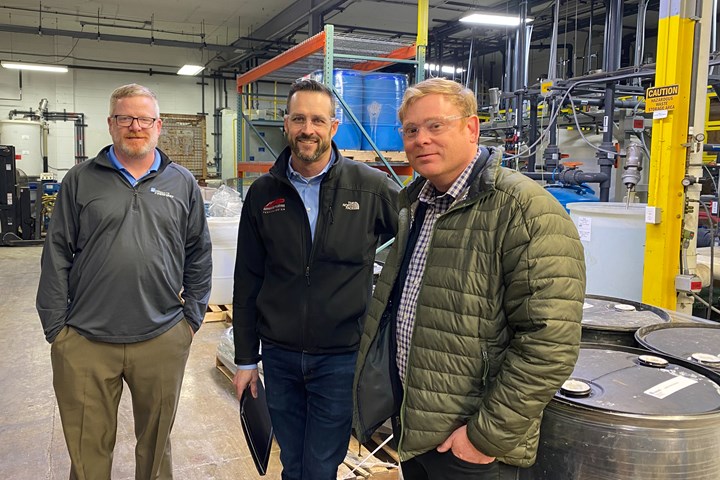On the Road
Products Finishing editor-in-chief Scott Francis contemplates the increasing return of business travel and the future of transportation markets for finishers.

On the road again, the Products Finishing team visited Advanced Plating Technologies (APT) in Milwaukee as part of a tour of Wisconsin finishing facilities in February. . Left to right: Todd Luciano, VP finishing and valve media for Gardner Business Media, Matt Lindstedt, president, APT; Scott Francis, editor-in-chief, Products Finishing.
Photo Credit: Products Finishing
At the time of this writing, I’m on my first business trip of the year. VP of finishing and valve media Todd Luciano and I flew to Wisconsin to visit finishing shops and suppliers in the Milwaukee, Green Bay area. It’s been a fun trip with lots of great conversations and a look inside some fantastic facilities.
I must admit however, it’s been a little odd getting back on the road. As much as I’m tired of writing about COVID and I’m sure everyone is tired of having to talk about it, the pandemic is a part of every trip, every business meeting, every working lunch, every conversation. All the things that should be simple require a little extra planning. It shouldn’t be a big deal, but it adds an extra element to normal travel-related stress and begins to wear at you. Of course, I’m also planning my Spring travel and looking toward events in the middle and later in the year. My calendar is filling up and it feels incredibly odd to be thinking about this much air travel. I expect some of you are experiencing the same strange feeling as you plan your own year. Ultimately, I think we are all approaching 2022 with cautious optimism. As the peak in Omicron variant infection wanes, could we finally be ready for some semblance of normalcy?
Of course, the real question for finishers is what does this all mean for the markets that their operations serve? After all, transportation in its various forms from aero to auto is a big piece of the pie for many finishers.
A look at market reports such as Deloitte paints an optimistic picture for aerospace. Demand for small- and medium-sized aircraft is reportedly on the rise. With air travel volume rebounding, aftermarket and MRO business seems to be increasing. As we travel more, we need more planes in the air and we need maintenance and repair for those planes.
What does that mean for the finishing industry? MRO work is certainly increasing. And yes, production of new airplanes has ramped up, but the standstill that the industry came to in 2020 left a backlog of aerospace parts sitting on shelves. And that will take some time to work through. Most experts don’t foresee airplane production reaching pre-pandemic levels until 2024. Meaning that for now, aerospace remains a long game for many finishers.
During the past couple of years, many finishing operations with aerospace as a large portion of their business shifted some of their focus to areas such as defense and space applications (mainly satellites), markets that showed more resilience during the pandemic. Many also adopted an increase in medical work and other market sectors that were either unaffected or saw more demand.
As we look forward, it is increasingly important for finishers to work in diversified markets. As I was out on the road visiting with finishers, most realize this and have their mind on a mix of the old and the new, exploring finishing in such application megatrends as electric vehicles (EVs) and advances in telecommunications.
The good news is that these markets within markets are expanding in terms of opportunities. The advent of EVs finally seems to have arrived. And while that market faces myriad challenges, it continues to grow and will likely only increase in momentum. Coaters and finishers have numerous opportunities as the need increases for an array of coatings that provide insulative properties, conductivity, fire-retardance and shielding. Some of the very hurdles that the widespread adoption of EVs present also means new opportunities. The infrastructure to support EVs is an area that requires a lot of work to make EV travel truly viable. Conductive parts for charging stations present an area of opportunity for the finishing industry as those vehicles continue to claim a share of the total transportation market.
Where we are now feels like a crossroads. The traditional ways of doing things will still be needed — expecting internal combustion engine (ICE) vehicles to suddenly disappear is unrealistic. Yet, an increasing amount of new technologies will emerge on the scene. Not to oversimplify, but the way forward is as it has always been — to embrace new opportunities, pivoting or expanding capabilities to meet the needs of the market.
Read Next
Celebrating Top Shops
The real way to be a Top Shop? Take care of your customers and your team.
Read MoreThe Year in Review
Products Finishing offers a look back at some of the most noteworthy finishing industry stories from 2021.
Read More






















